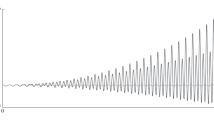Abstract
A mathematical model of the hydrodynamics of free closed surfaces in a fluid is expounded. It is used for studying the dynamics of ellipsoidal cavities during their development. The model is based on a system of differential equations that accounts for the influence exerted on the dynamics of cavities by various perturbations such as gravity, surface tension, viscosity, and geometrical features of the cavity. Solving this system makes it possible to determine the hydrodynamic characteristics of the flow around the cavity and to plot cavity shapes depending on time and flow regimes. Characteristic features of the development of such cavities under gravity and surface tension are established
Similar content being viewed by others
References
V. N. Buivol, Thin Cavities in Disturbed Flows [in Russian], Naukova Dumka, Kiev (1980).
V. N. Buivol and Yu. R. Shevchyuk, “Deformation equations for a floating-up bubble,” Dokl. AN USSR, Ser. A, No. 5, 34–37 (1987).
V. V. Voronin and T. N. Machekhina, The Present State of the Art in Research on Cavitation Flows (Reviews) [in Russian], 651, ONTI TsAGI, Moscow (1985).
R. T. Knapp, J. W. Daily, and F. G. Hammitt, Cavitation, McGraw Hill, New York (1970).
J. P. Best, “The formation of toroidal bubbles upon the collapse of transient cavities,” J. Fluid Mech., 251, 79–107 (1993).
J. P. Best and A. Kucera, “A numerical investigation of nonspherical rebounding bubbles,” J. Fluid Mech., 245, 137–154 (1992).
J. R. Blake, P. B. Robinson, A. Shima, and Y. Tomita, “Interaction of two cavitation bubbles with a rigid boundary,” J. Fluid Mech., 255, 707–721 (1993).
A. F. Dashchenko and Yu. M. Dudzinskii, “Natural oscillations of a jet membrane under hydrostatic pressure,” Int. Appl. Mech., 40, No. 12, 1385–1390 (2004).
V. T. Grinchenko, “Wave motion localization effects in elastic waveguides,” Int. Appl. Mech., 41, No. 9, 988–994 (2005).
A. N. Guz and A. P. Zhuk, “Motion of solid particles in a liquid under the action of an acoustic field: the mechanism of radiation pressure,” Int. Appl. Mech., 40, No. 3, 246–265 (2004).
W. A. H. J. Herman, “On the instability of the translating gas bubble under the influence of a pressure step,” Fhilips Res. Repts Suppl., No. 3, 2–26 (1973).
V. D. Kubenko, “Impact of blunted bodies on a liquid or elastic medium,” Int. Appl. Mech., 40, No. 11, 1185–1225 (2004).
M. S. Plesset and A. Prosperitti, “Bubble dynamics and cavitation,” Ann. Rev. Fluid Mech., No. 9, 145–185 (1977).
Author information
Authors and Affiliations
Additional information
__________
Translated from Prikladnaya Mekhanika, Vol. 42, No. 2, pp. 24–31, February 2006.
Rights and permissions
About this article
Cite this article
Buivol, V.N. Dynamics of ellipsoidal cavities in fluid. Int Appl Mech 42, 145–151 (2006). https://doi.org/10.1007/s10778-006-0069-0
Received:
Issue Date:
DOI: https://doi.org/10.1007/s10778-006-0069-0




